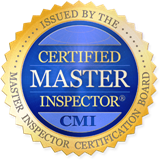

Certified Master Inspector
Providing Residential and Commercial Property Inspections for Muskoka
8 a.m. to 7 p.m., 7 Days a Week
Call 705 205 4663
DoneRight1@live.ca
8 a.m. to 7 p.m., 7 Days a Week
Call 705 205 4663
DoneRight1@live.ca


Radon comes from the natural breakdown of uranium in soil, rock and water. As it breaks down it releases a gas which is called Radon. The release of this radioactive gas enters the air you breathe, causing a potential health risk to you and your family. Radon gas can be found just about anywhere. It can get into any type of building -- homes, offices, and schools -- and build up to high levels. You can't see or smell radon because it is a colorless odorless gas
What you should know about Radon
 Radon is a cancer causing radioactive gas. In fact according to the EPA, CMHC, and the U.S. Surgeon General it is the second largest cause of lung cancer, rating even above second hand smoke. (See Note end of page) and; it may be a problem in your home.
Radon is a cancer causing radioactive gas. In fact according to the EPA, CMHC, and the U.S. Surgeon General it is the second largest cause of lung cancer, rating even above second hand smoke. (See Note end of page) and; it may be a problem in your home.
This is because when you breathe air-containing radon, you increase your risk of getting lung cancer. You should test for radon. Testing is the only way to find out about your home's radon level. The EPA and the Surgeon General recommend testing of all homes below the third floor for radon.
You can fix a radon problem.
If you find that you have high radon levels, there are ways to fix a radon problem. Even very high levels can be reduced to acceptable levels.
If you are buying a home EPA and the CMHC recommends that you obtain the radon level in the home you are considering buying.
The Canada Mortgage and Housing Corporation recommends Remedial measures should be undertaken in a dwelling when the annual average radon concentration exceeds 200Bq/l (about 5.2pCi/L) in the normal occupancy area.(From Radon A guide for Canadian Homeowners.)
If elevated levels are found it is recommended that these levels be reduced. In most cases, a professional can accomplish this at reasonable cost or a homeowner can install a mitigation system that adheres to the EPA's approved methods for reduction of radon in a residential structure.
What are the Risk Factors?
The EPA, Surgeon General and The Center for Disease Control, have all agreed that continued exposure to Radon gas can cause lung cancer.
In fact, their position on the matter is that all homes should be tested for radon gas exposure, and all homes testing over 4 pCi/L should be fixed.
How Does Radon Enter the Home?
Typically the air pressure inside your home is lower than the pressure in the soil around your home's foundation. Due to this difference, your house acts like a vacuum, drawing radon gas in through foundation cracks and other openings of your home.
Radon may also be present in well water and can be released into the air in your home when water is used for showering and other household uses.
Potential Entry Points:
1. Cavities inside walls 2. Cracks in solid floors 3. Construction joints
4. Cracks in walls 5. The water supply 6. Gaps in suspended floors
7. Gaps around service pipes
Radon Testing
We do Radon testing for home buyers as a presale investigation, and for homeowners as a service. Lab analyzing of testing materials is required. Please see section on Water, Radon, and Mould tests for information on these tests and Fees.
(note) U.S. Surgeon General Richard H. Carmona warned the American public about the risks of breathing indoor radon by issuing a national health advisory today. The advisory is meant to urge Americans to prevent this silent radioactive gas from seeping into their homes and building up to dangerous levels. Dr. Carmona issued the advisory during a two-day Surgeon General's Workshop on Healthy Indoor Environment.
Indoor radon is the second-leading cause of lung cancer in the United States this also applies to Canada, and breathing it over prolonged periods can present a significant health risk to families all over the county, Dr. Carmona said. It's important to know that this threat is completely preventable. Radon can be detected with a simple test and fixed through well-established venting techniques.